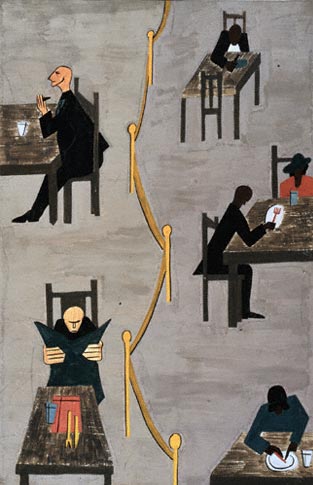The Migration of the Negro
The Migration of the Negro, Panel no. 49. Jacob Lawrence. 1940– 1941 C.E. Casein tempera on Hardboard.
They also found discrimination in the North although it was much different from that which they had known in the South.
- Series of small paintings. 60 in total.
- Documents migration of African Americans; young artist, age 24.
- Agricultural south to industrial north at the end of 19th/beginning of 20th centuries.
- Labor in the north, racism in south influenced this move; 6 million people moved; Lawrence’s family was one of them.
- New York, Chicago, St. Louis, Pittsburgh; industrial centers.
- Geometric shapes; flat colors; education, domesticity, labor, travel; series is about movement and change; train stations; trains packed continuously with migrants; new life in urban centers; unable to make a living in south, flooding; poverty, food had doubled in price; south lost labors, crops died; frequently arrested; child labor, lack of education in south; better housing conditions; press/news influenced people; labor camps; forced into crowded homes; housing was a difficult problem; discrimination prevailed; antagonism; race riots; bombing of negro homes; recreation/distraction/community found in churches; death rate high; cramped homes led to tuberculosis; doctors/female workers last to leave, followed their clients; better education; freedom to vote; migrants kept coming
- Panel no. 49: Ropes separated african americans from white americans; bird’s eye view; African figures silhouetted, sense of isolation; distance; back and forth composition, white people are the only ones with their facial features depicted; white figures seem aloof/menacing.
- Overall color unity; unmodulated colors; flat simple shapes; collective African-American experience; little individuality in figures; narrative
